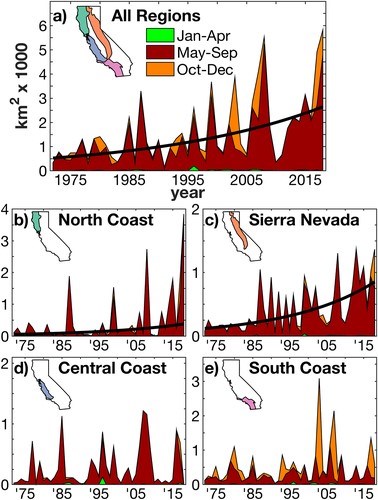Last updated: September 3, 2019
Article
How is Climate Change Already Impacting California Wildfires?

Williams, A. P., Abatzoglou, J. T., Gershunov, A., Guzman‐Morales, J., Bishop, D. A., Balch, J. K., & Lettenmaier, D. P. ( 2019).
August 2019 - The area burned by wildfires each year in California is five times higher now than it was in the early 1970s. In addition, models of the impacts of climate change on wildfire in California generally predict increases in wildfire frequency and burned area. But how well do models explain the particular changes in wildfire patterns that have already occurred? A new article in Earth's Future attempts to untangle the intricacies of how, where, when, and why California wildfires have increased, and clarify where climate change fits in. Highlights of the authors’ findings include:
-
Most of the increase in burned area seen since 1972 has been because of an increase in summer forest fires, mostly in Northern California and the Sierras. That increase, in turn, can be almost entirely explained by a rise in aridity, which is caused by warming, and consistent with climate change models. Just a small amount of warming causes exponential increases in aridity, drying out fuels, so summer forest fires could get a lot worse with further warming if fuels remain abundant.
-
Summer fires in non-forested parts of California, mainly Central and Southern, were mostly linked to dry years following wet ones. There was a weaker link between these fires and climate change.
-
Fall wildfires have increased significantly in recent decades, but their causes are more complex. The authors find a weak link between climate change and fall wildfires like those that devastated parts of the state in 2017 and 2018. The link between fall fires and climate change is expected to grow stronger in the future.
Check out the full article, Observed Impacts of Anthropogenic Climate Change on Wildfire in California, for more details.
